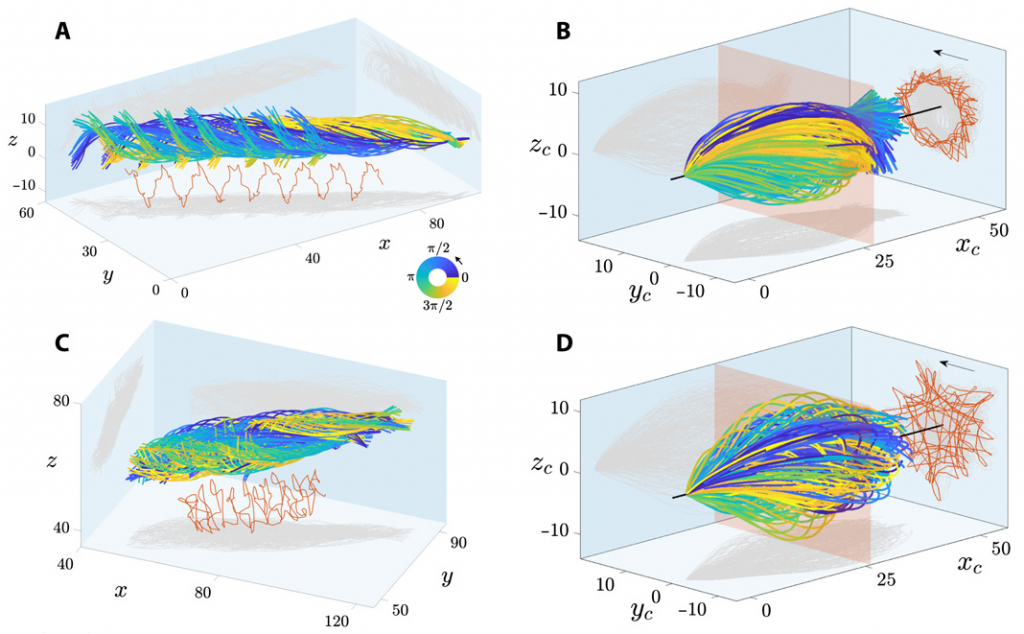
Everybody out of the pool.
The authors of a 2020 paper in Science Advances on how human sperm propel themselves in a corkscrew fashion like “playful otters” have retracted their article after concluding that their analysis didn’t support their conclusions.
The article, by Hermes Gadêlha, of the University of Bristol, in England, and several colleagues in Mexico, spawned significant coverage in the lay and science press — including this segment on NPR’s Science Friday and an article in Science (the work behind it was the subject of this YouTube video titled “The great sperm race”).
At the heart of the paper, “Human sperm uses asymmetric and anisotropic flagellar controls to regulate swimming symmetry and cell steering,” was the use of a technology called high-speed 3D microscopy to analyze sperm in motion. Per the abstract:
High-speed three-dimensional (3D) microscopy revealed two coactive transversal controls: An asymmetric traveling wave creates a one-sided stroke, and a pulsating standing wave rotates the sperm to move equally on all sides. Symmetry is thus achieved through asymmetry, creating the optical illusion of bilateral symmetry in 2D microscopy. This shows that the sperm flagellum is asymmetrically controlled and anisotropically regularized by fast-signal transduction. This enables the sperm to swim forward.
Or, as Gadêlha told CNN:
Human sperm figured out if they roll as they swim, much like playful otters corkscrewing through water, their one-sided stroke would average itself out, and they would swim forwards.
The rotation of the sperm is something that is very important. It’s something that allows the sperm to regain a symmetry and actually be able to go straight.
But within two weeks of publication, Science Advances issued an expression of concern about the paper, noting controversy over whether the researchers had adequate support for their conclusions:
In the 31 July 2020 issue, Science Advances published the Research Article “Human sperm uses asymmetric and anisotropic flagellar controls to regulate swimming symmetry and cell steering” by H. Gadêlha, P. Hernández-Herrera, F. Montoya, A. Darszon, and G. Corkidi (1). The corresponding authors have now notified Science Advances of the concern that, upon reexamination, sections of the mathematical analysis in the paper are not fully able to either prove or disprove a core conclusion of the article, namely that the flagellar beat in human sperm is asymmetric. A re-analysis by the authors is underway, and Science Advances is publishing this Editorial Expression of Concern to alert our readers while we await the outcome.
After what we’d consider a rather pregnant pause of nine months, the journal has retracted the article, which has been cited 11 times, according to Clarivate Analytics’ Web of Science, all after the EoC appeared. (The EoC itself has been cited once.)
Science Advances is publishing a Retraction for the article “Human sperm uses asymmetric and anisotropic flagellar controls to regulate swimming symmetry and cell steering,” by Hermes Gadêlha and colleagues, at the request of all 5 authors of the original paper. After publication, readers of the paper had identified that asymmetry and anisotropy in sperm cell flagella – a main conclusion of the paper – cannot be determined unequivocally using only 3D flagellar waveform data. The authors have therefore retracted the paper, on the grounds that the description of flagellar asymmetry and anisotropy contained therein is incomplete.
Although the authors are to be commended for retracting their paper, we’re wondering where the peer reviewers were on this one. After all, presumably if it was immediately obvious to readers that 3D flagellar waveform data were not conclusive … shouldn’t expert reviewers have caught that, too?
Gadêlha did not respond to a request for comment. Asked by Retraction Watch whether he felt the peer review for the paper was adequate, Holden Thorp, the editor-in-chief of the Science journals, said he had nothing to add beyond the retraction notice.
Like Retraction Watch? You can make a one-time tax-deductible contribution or a monthly tax-deductible donation to support our work, follow us on Twitter, like us on Facebook, add us to your RSS reader, or subscribe to our daily digest. If you find a retraction that’s not in our database, you can let us know here. For comments or feedback, email us at [email protected].
Seems like a big failure of peer review.
Peer review needs to be reviewed.
This article seems a bit unprofessional and nasty in tone.
The research paper was ill handled on the part of the journal and it is entirely their fault. If the journal’s editors had concerns this should have been dealt with during the review process, not just passing responsibility to the expert reviewers – who presumably corrected what they saw fault in.
To the authors’ great credit – they retracted the article to ensure their academic integrity and reputation remained intact.
This sort of juvenile cattiness serves as dis-incentive for people to retract. I would much prefer to see colleagues lauded for integrity than bashed.